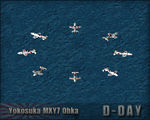Difference between revisions of "Yokosuka MXY7 Ohka"
From D-day: wiki
| Line 22: | Line 22: | ||
==References== | ==References== | ||
*[http://en.wikipedia.org/wiki/Yokosuka_MXY7_Ohka Wikipedia] | *[http://en.wikipedia.org/wiki/Yokosuka_MXY7_Ohka Wikipedia] | ||
| + | |||
| + | }} | ||
| + | |||
| + | |||
| + | {{Timeframe | ||
| + | |||
| + | |midwar=yes | ||
| + | |latewar=yes | ||
| + | |totalwar=yes | ||
}} | }} | ||
Revision as of 09:31, 13 August 2014
| ||||||||||||||||
History
The MXY-7 Ohka was a small rocket powered plane made specifically for kamikaze missions. The Ohka had a very short range and required a Mitsubishi G4M carrier aircraft to transport them to their target, after launch the Ohka was able to reach speeds up to 1,000 km/h making it nearly impossible to intercept. The first missions were carried out in April 1945 during the battle of Okinawa sinking a destroyer and several transports. After this battle the Americans deployed larger aerial defense screens that intercepted the G4M carrier aircraft before they could launch the Ohka. Over 800 MXY-7 Ohka were built by the end of the war, most of them were placed along the Japanese coastline in anticipation of the Allied invasion, where the short range wasn't a problem and they could be launched from rails on the ground.
References
. . . .
Time Frames
| 1930 - 1940: Pre-War |
1940 - 1942: Early-War |
1942 - 1944: Mid-War |
1944 - 1945: Late-War |
1945 - 1960: Post-War |
1930 - 1960: Total-War |
|
| Buildable | Yes | Yes | Yes | |||
| Bonus Crate |
. . . .

